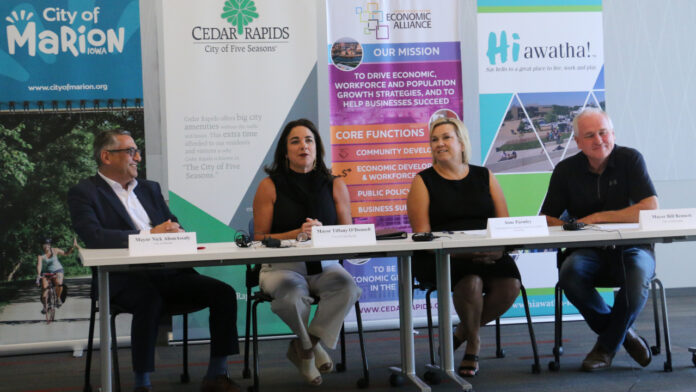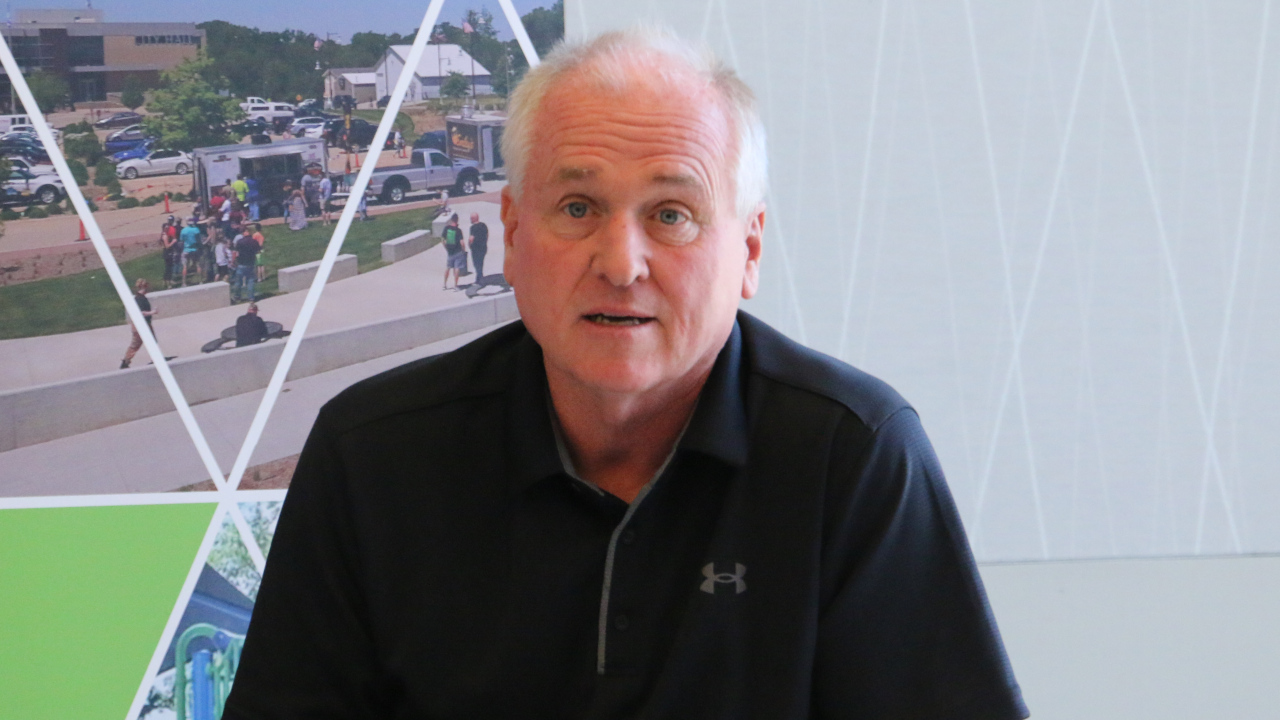
Historically, communities in the Cedar Rapids metropolitan area have found themselves competing for economic development successes, from attracting new employers to the area to incentivizing the growth of current employers.
But when it comes to the persistent issue of workforce recruitment, local leaders agree: a rising tide lifts all boats. And a new campaign is now under way to target that issue.
The mayors of the cities of Cedar Rapids, Marion and Hiawatha, along with the Cedar Rapids Metro Economic Alliance (CRMEA), jointly announced Thursday, Aug. 24 a new collaborative initiative focused on growing the region’s workforce pool.
Cedar Rapids Mayor Tiffany O’Donnell, who first discussed the new campaign at a CRMEA-hosted developer and contractor luncheon in May, said every city in the Cedar Rapids metro area has been on an economic “growth trajectory” in recent years.
“It’s a great time to be in all of our cities,” Ms. O’Donnell said. “The one concern we have is what we hear from constituents and business owners and businesses that we’re trying to attract, and that’s workforce. And for the first time, we are being extremely intentional about workforce. We’re not just talking about it any more.”
The four partnering organizations have contracted with Development Counsellors International (DCI) to lead the new initiative, and will split the estimated $115,000 contract costs on a proportional basis.
Founded in 1960 and headquartered in New York City, DCI has represented more than 500 regions, states and counties in workforce attraction efforts, including the Des Moines Convention and Visitors Bureau, the Greater Des Moines Chamber of Commerce Federation, the Iowa Economic Development Authority and Travel Iowa.
DCI will spearhead the first phase of the initiative, which will focus on gathering data from the metro area, describing national workforce trends, assessing local market strengths and identifying key markets to target with workforce recruitment efforts. That phase is expected to take about nine months to complete.
The second phase will then focus on implementation strategies and marketing campaigns guided by the data and research collected by DCI.
Ms. O’Donnell acknowledged that other workforce recruitment initiatives have been undertaken in the region and statewide, and noted the new initiative is intended to complement those efforts.
“Please know that all of this is happening alongside (those efforts)” she said. “We’ve had conversations with the state as well to make sure that we’re not duplicating (them). In fact, we can push off of the work that they’re already doing on a state level and just drill it down a little bit closer to our goals.”
Anne Parmley, vice chair of the Cedar Rapids Metro Economic Alliance’s policy board, said many regions nationwide face workforce shortages, and that while some segments of the workforce have been returning to the labor market from the COVID-19 pandemic, other segments – such as workers age 55 and over – have been returning to work more slowly, or not at all.
“This is something a lot of marketplaces are challenged by, and if they don’t go after it with intent, they’re just setting themselves up for failure,” she said. “I think this is a prime time to be doing this. I don’t think there’s ever been a better time to attract people to the metro area. There’s great things going on in our communities, and those who come and choose to live here are very vocal about it.”
Marion Mayor Nick AbouAssaly said since taking office, he’s had several conversations with Ms. O’Donnell regarding collaboration on workforce recruitment initiatives.
“Regional collaboration around this effort just makes sense for all of us,” he said.
He noted that Marion’s population growth – 19% in the past decade – has been driven primarily by prioritizing the city’s quality of life through the development of new amenities, and the new effort can help maintain that momentum.
“We’ve focused on making our community the best small city in America,” he said. “And in turn, we want to do our part to help make the region the place where people want to be and where businesses want to be, and I know that we can do it by working together. My mother always used to say that one hand cannot clap alone. And with the power of partnership with collaboration, and the value that every organization brings to this effort, I know that we can achieve whatever goals we set.”
For his part, Hiawatha Mayor Bill Bennett said when he was approached to support the initiative, he was on board immediately.
“We talked about how we bring our kids back, to be excited to stay in the area and be around their families,” he said. “We see so many of our kids run off to the big cities, and there’s so many things to do and so many options. Cedar Rapids has that same effect. We’ve just got to fine-tune it. Hiawatha being a younger city, some of the challenges that Tiffany faces we haven’t got to face yet, but they’re coming, and we know that we’re going to be in the same situations. We all know that it’s not just our city – our state and other states and cities around us have the same issues with the lack of workforce. We hope that we can bring a reason to be in our area, with all of us getting on board (for) the same end result.”
Mr. AbouAssaly noted that he hopes the new campaign can stress the area’s quality of life amenities to help attract new residents.
“This effort is to help us identify all the assets, all the wonderful things about living here and and figure out how to tell that story,” he said. “What are the various strategies for reaching out to audiences across the country to share the benefits of living in this region? We all know there are lots of great benefits. Certainly there are challenges as well, because we are competing with places that have great weather year-round, and beaches, and mountains. But we’ve all gotten much better at doing things like placemaking, creating places that are attractive for people to see themselves enjoying life here. And we want to come together and figure out how to tell that story collectively, as a region, to attract more people here.”
Ms. O’Donnell also stressed that the effort will need to reach beyond government and economic development officials to be successful.
“While we’re all partners up here, it’s going to require partners out there,” she said. “And that’s not just the citizens of our communities. We’re going to call on leadership in our business communities to tell the story as well.”
She noted that Cedar Rapids has worked with consultants in the past, including AngelouEconomics, to learn how Eastern Iowa is perceived nationally.
“We have an idea that people that know us like to work with us,” she said. “But there were a lot of people that didn’t know anything about us. There was no feeling, good or bad. We’ve got to work on that, and I think we’ll have a great story to tell.”
It’s not yet clear what regions will be targeted for workforce recruitment efforts, Ms. O’Donnell said.
“We anticipate that the consultant will identify a handful of cities,” she said. “And maybe one of the questions will be, where do our people end up – those who are from here or went to college in the area – and are there common threads as to where they are? Then we can go find them and make it interesting for them to come home.”
Mr. AbouAssaly said metro area communities decided to work together on this issue because workforce recruitment and retention is a shared goal.
“This issue has no boundaries,” he said. “Workforce attraction benefits all of us, because whichever city (people) decide to live in, they’re going to work in the region, they’re going to shop in the region, they’re going to do things in the region. So it truly is an opportunity for all of us to work on something we have in common. We all want our respective cities to thrive, but I think this is a realization that we all can drive together, and we all can benefit from working together. It’s not a zero-sum game, and it’s not a limited pie. We can all grow together and cheer for each other, and this is a chance for us to show that to the region, the community and the nation.”








